This Dominican Sancocho recipe is a hearty three meat stew filled with robust flavors of sazon, adobo and packed with hearty bites of yucca, plantain and corn. The hearty vegetables soak up the flavorful stock, making this stew a delicious, comforting dish.
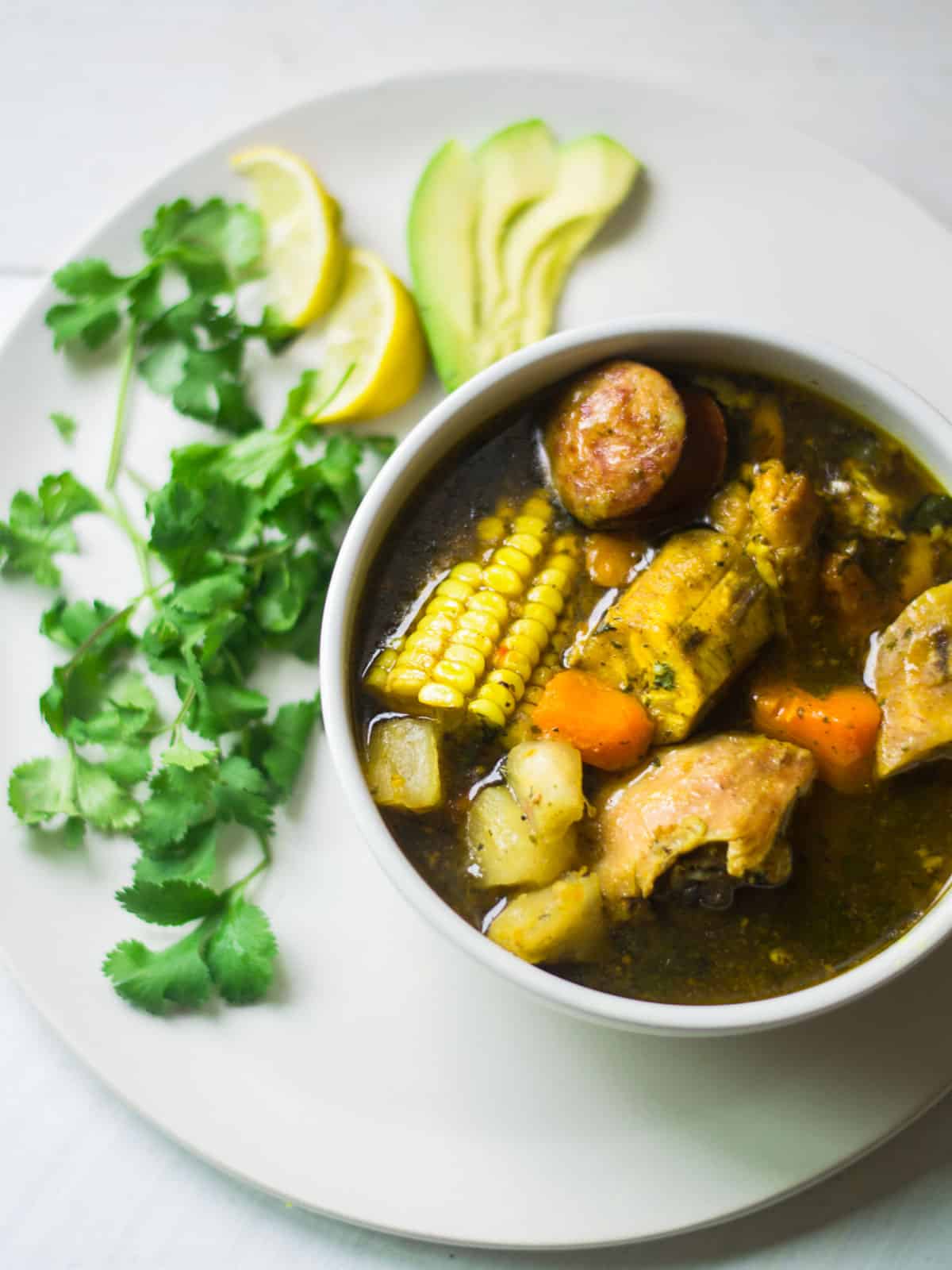
Jump to:
About This Recipe
This Sancocho recipe is a very humble homage to the people of the Dominican Republic and to the country's national dish. It's typically served and made on special occasions, such as weddings or large family parties. For another South American stew, try my Argentinian beef stew.
The Sancocho Dominicano I made is a three meat stew filled with yucca, plantains and butternut squash. I seasoned the meat with adobo spices, including my homemade sazon seasoning, and added big flavors of sofrito and bouillon to the stock.
I couldn't find some of the traditional root vegetables that would normally go into the sancocho recipe at my local mercado, so I stuck to root vegetables that were available, such as butternut squash and yucca. The hearty vegetables soak up all the delicious stock and gets better the longer the sancocho sits.
📋 Ingredients
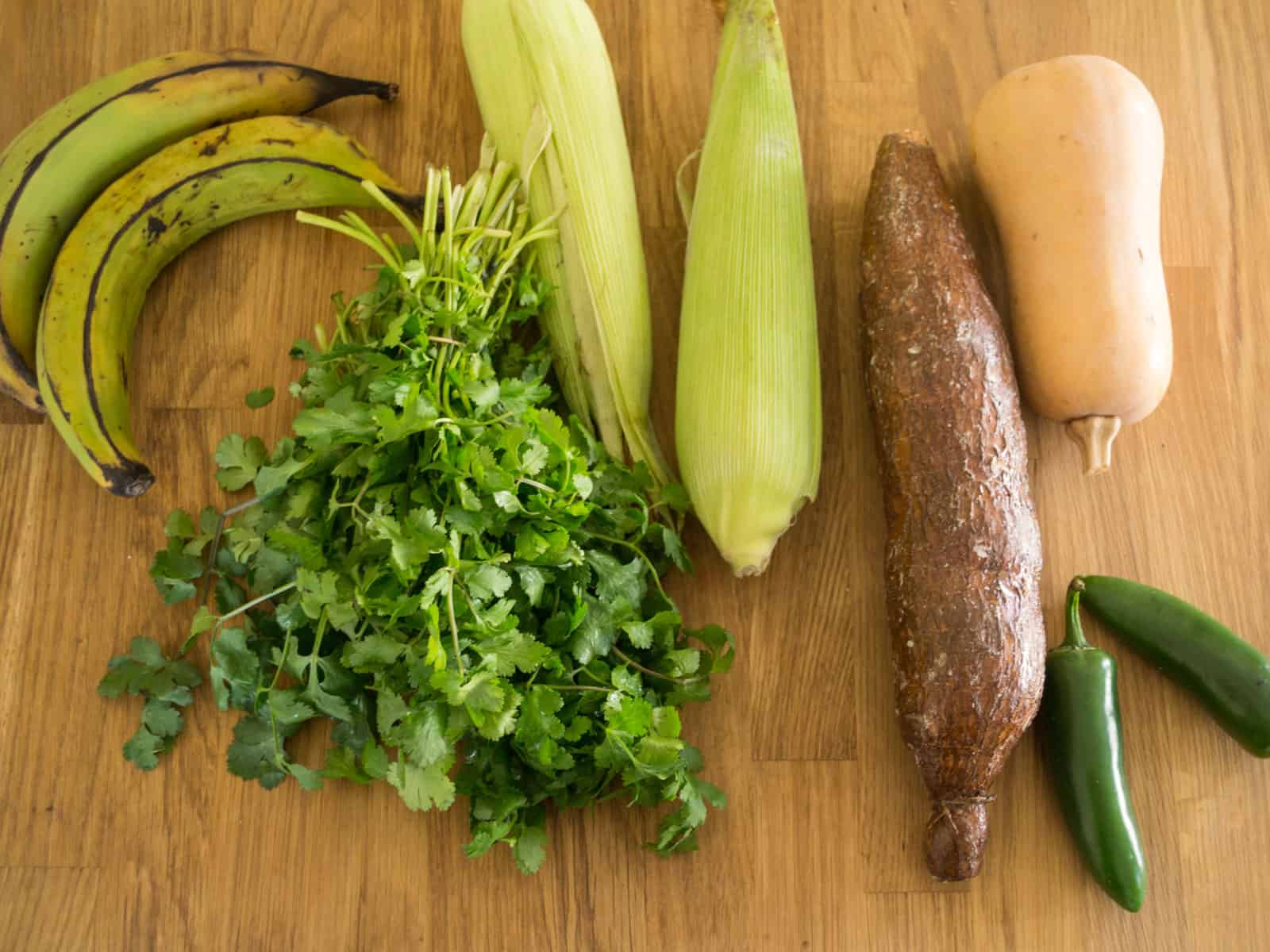
Sancocho Vegetables
- Plantains: They look similar to unripe bananas but they have a completely different flavor. Look for firm plantains with a green peel. Green plantains are starchy and better for frying, while yellow to black plantains are sweeter and better for sweet fried plantains.
- Corn: Purchase fresh, sweet corn on the cob, choosing ears with bright green husks.
- Yucca: Yucca, also known as cassava, is a root vegetable commonly used in Latin American cuisine. Yucca is very starchy with a thick brown peel that needs to be peeled away. Yucca is great in stews, such as this as well as fried.
- Butternut Squash: Butternut squash is a winter squash with a sweet, nutty flavor. You cna also use Kabocha squash.
- Cilantro: Cilantro will give the stew a bright and herby aroma. You can substitute with fresh parsley if cilantro isn't available.
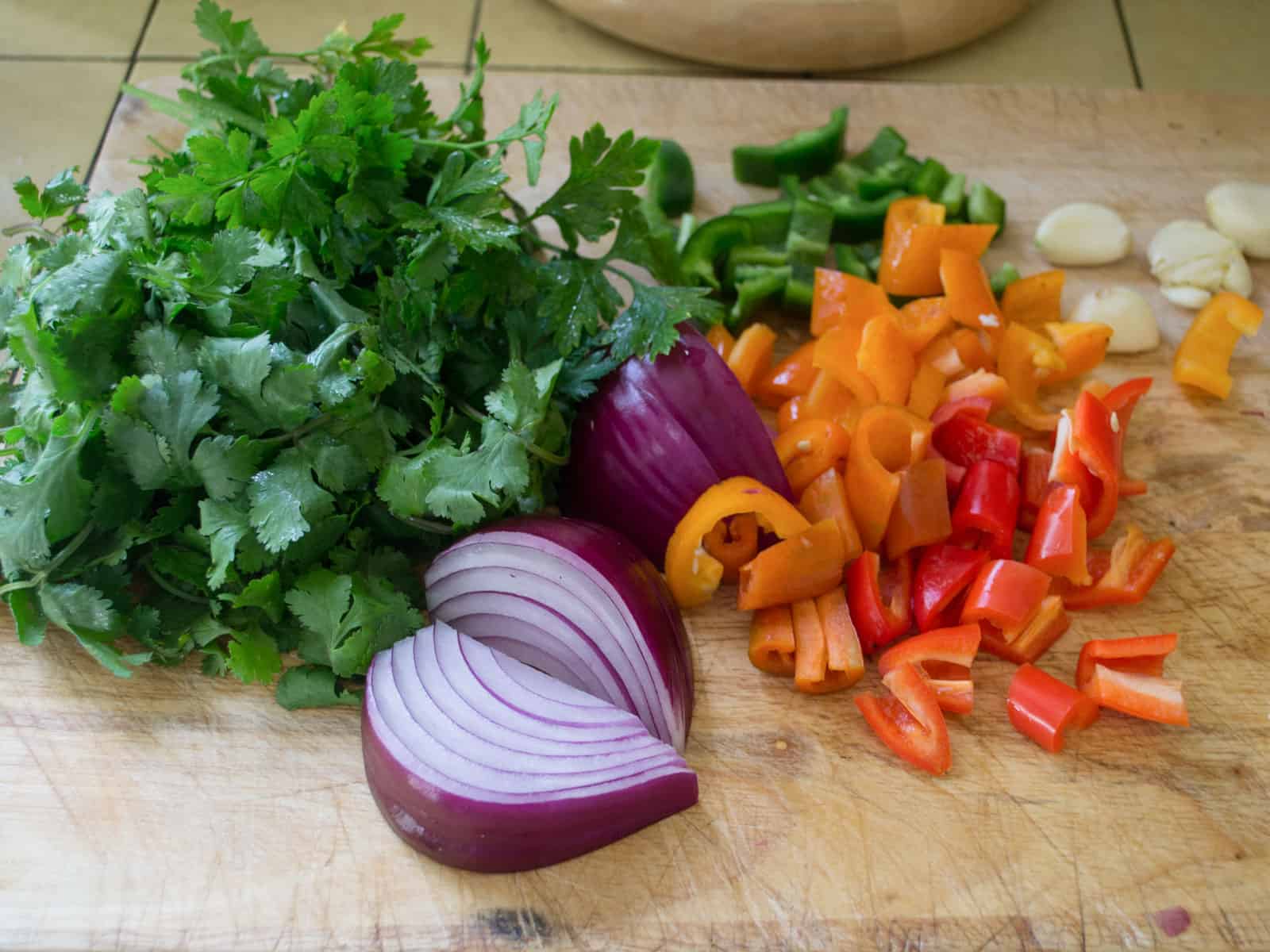
Sofrito
Sofrito is a flavorful base used in Latin American, Spanish, and Caribbean cuisines. The mixture is a blend of herbs and aromatics and when sauteed, creates a rich base for stews and soups.
- Cilantro: Fresh cilantro will give a fresh herby flavor to the sofrito. If you don't like it, you can substitute it with fresh parsley.
- Onion: Use red onion for a stronger flavor. Alternatively, you can use white or yellow onions, or shallots.
- Bell Pepper: You can use a mix of green, orange and red bell peppers, or only use red bell pepper, as you prefer.
- Garlic: Garlic is essential to give the sofrito an incredible aroma.
- Jalapeño: Jalapenos will add a bit of spice to the stew without being overwhelming. You can remove the seeds to decrease the level of spiciness, or use a differen variety of chili to increase the heat.
See recipe card for full information on ingredients and quantities.
⏲️ Instructions
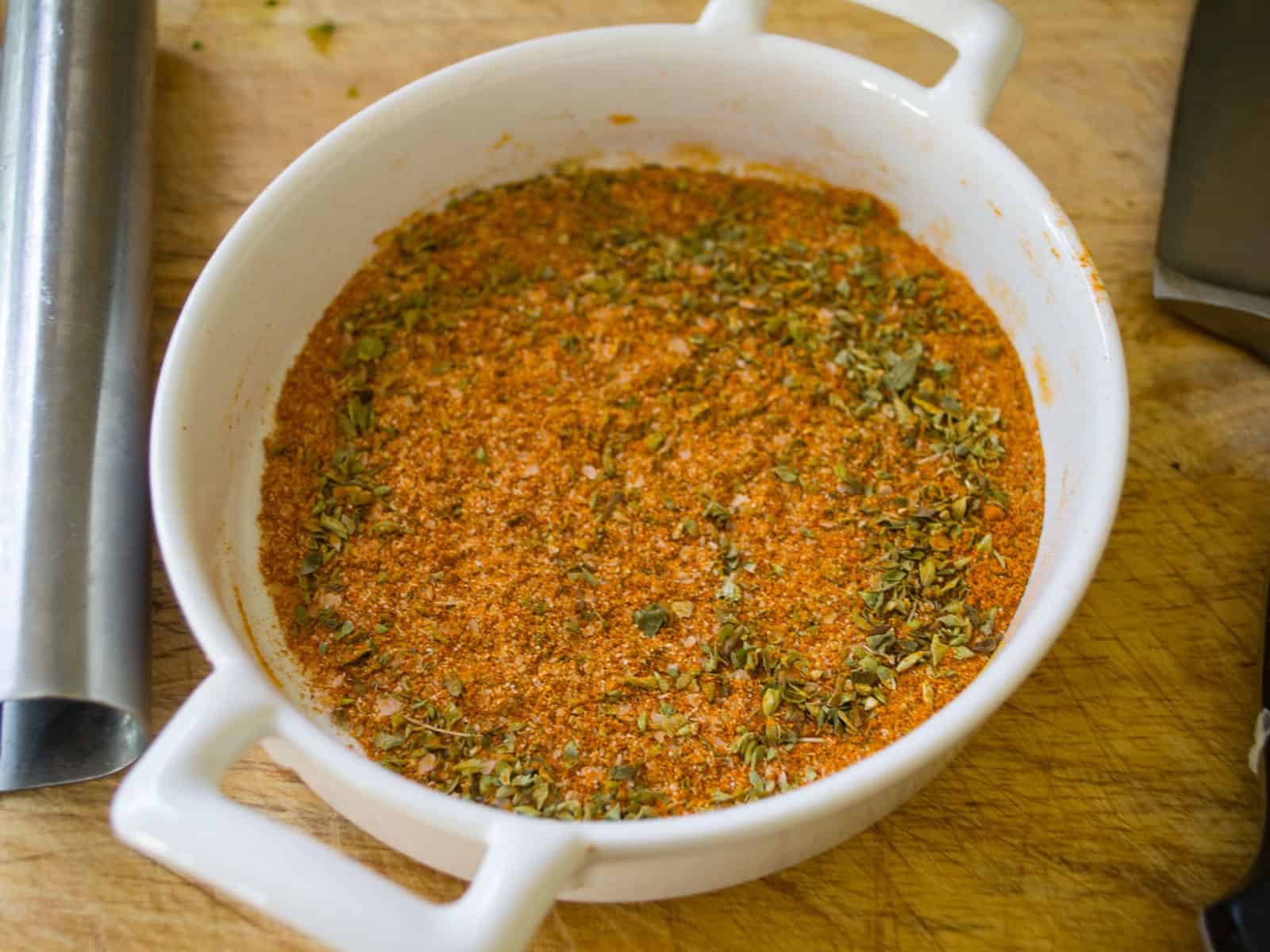
Step 1. Add all the adobo spices together in a bowl and mix well. Do the same with the sazon.

Step 2. Season the chicken thighs and pork bones with adobo, sazon seasoning, salt and pepper.

Step 3. Drizzle olive oil in a large dutch oven and sear the pork bones and chicken on both sides until outside is golden brown. Then add sausage and sear on both sides.
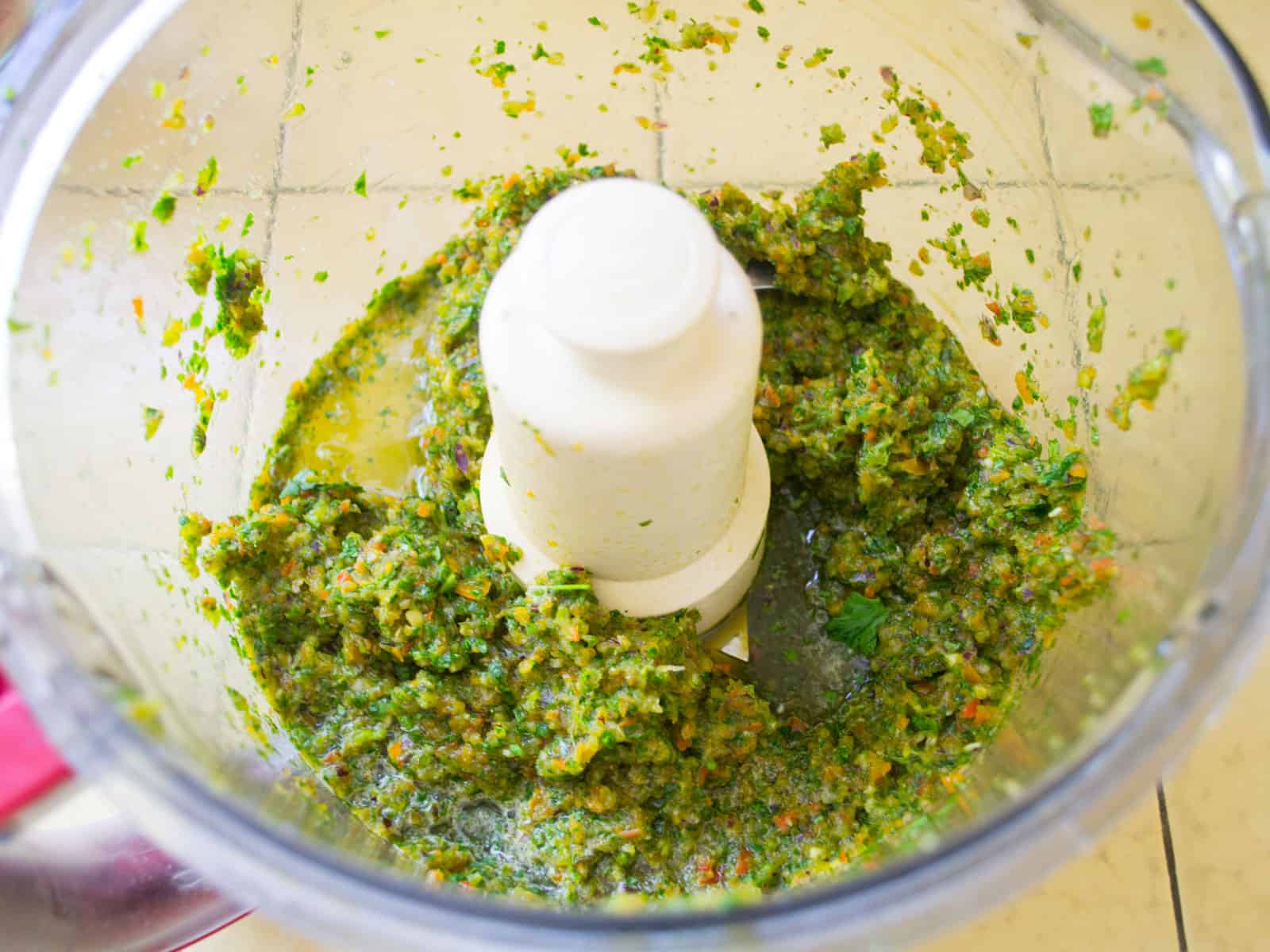
Step 4. Make the sofrito. To a food processor, add a bunch of fresh parsley, onion, garlic cloves, jalapeño and bell peppers. Give everything a good blend until well combined, but still has some texture to it.

Step 5. Add 2 heaping tablespoons of sofrito to the pot, stirring a bit to coat everything. Pour in 8 cups of chicken stock and stir everything together. Bring the stew to a boil and then down to a simmer for 20-30 minutes until the chicken is cooked through.
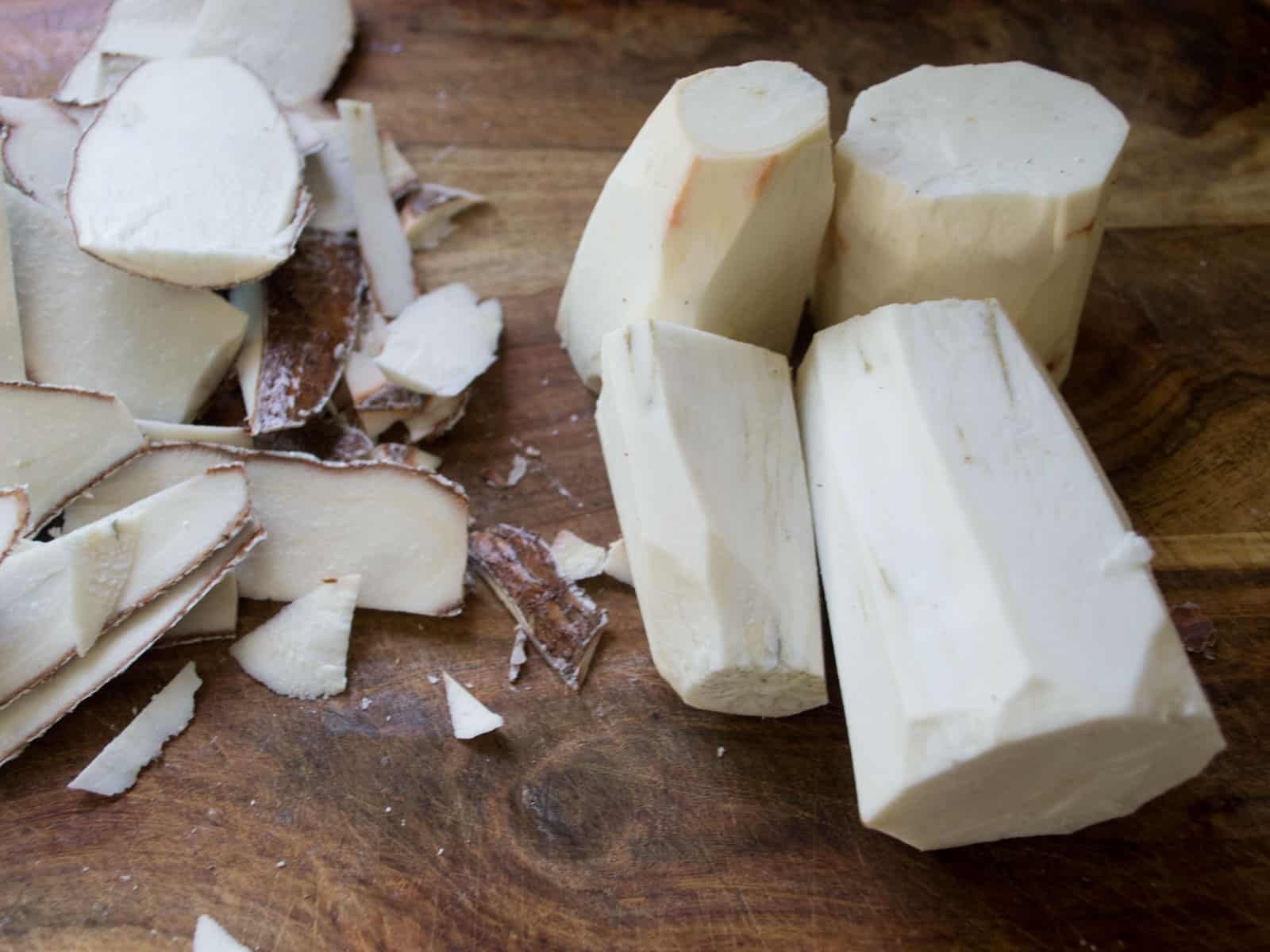
Step 6. While stew simmers, prep the vegetables. Yucca has a very thick waxy exterior, so take your time peeling and cut into large 1-2 inch pieces.
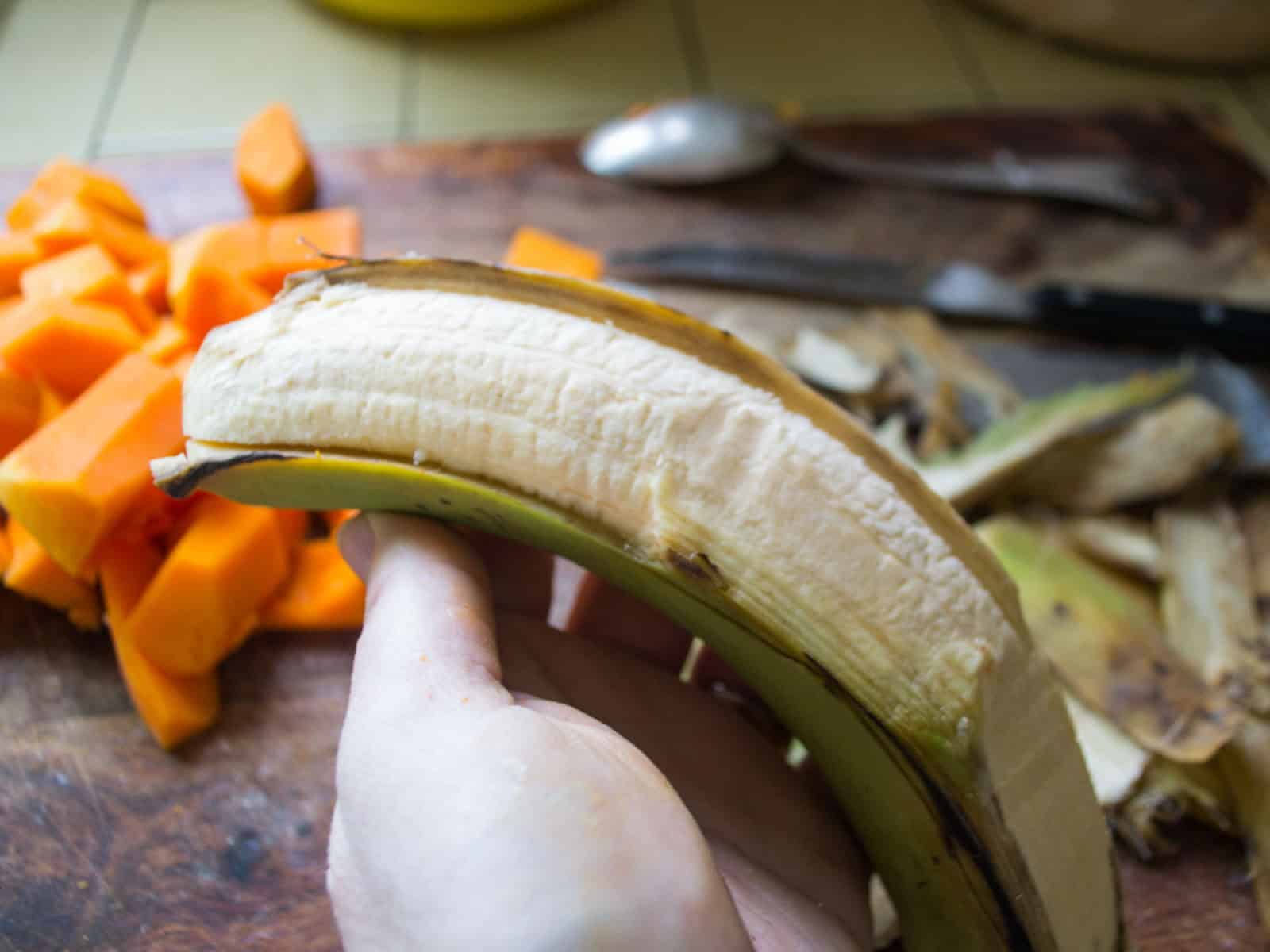
Step 7. Use a knife to remove the peels from the green plantain and cut into 1 inch pieces. Do the same with the butternut squash.

Step 8. Add the yucca, plantains and corn and continue cooking the stew for 10 minutes until they begin to soften. Then add the butternut squash and a handful of fresh cilantro and season with salt and pepper.
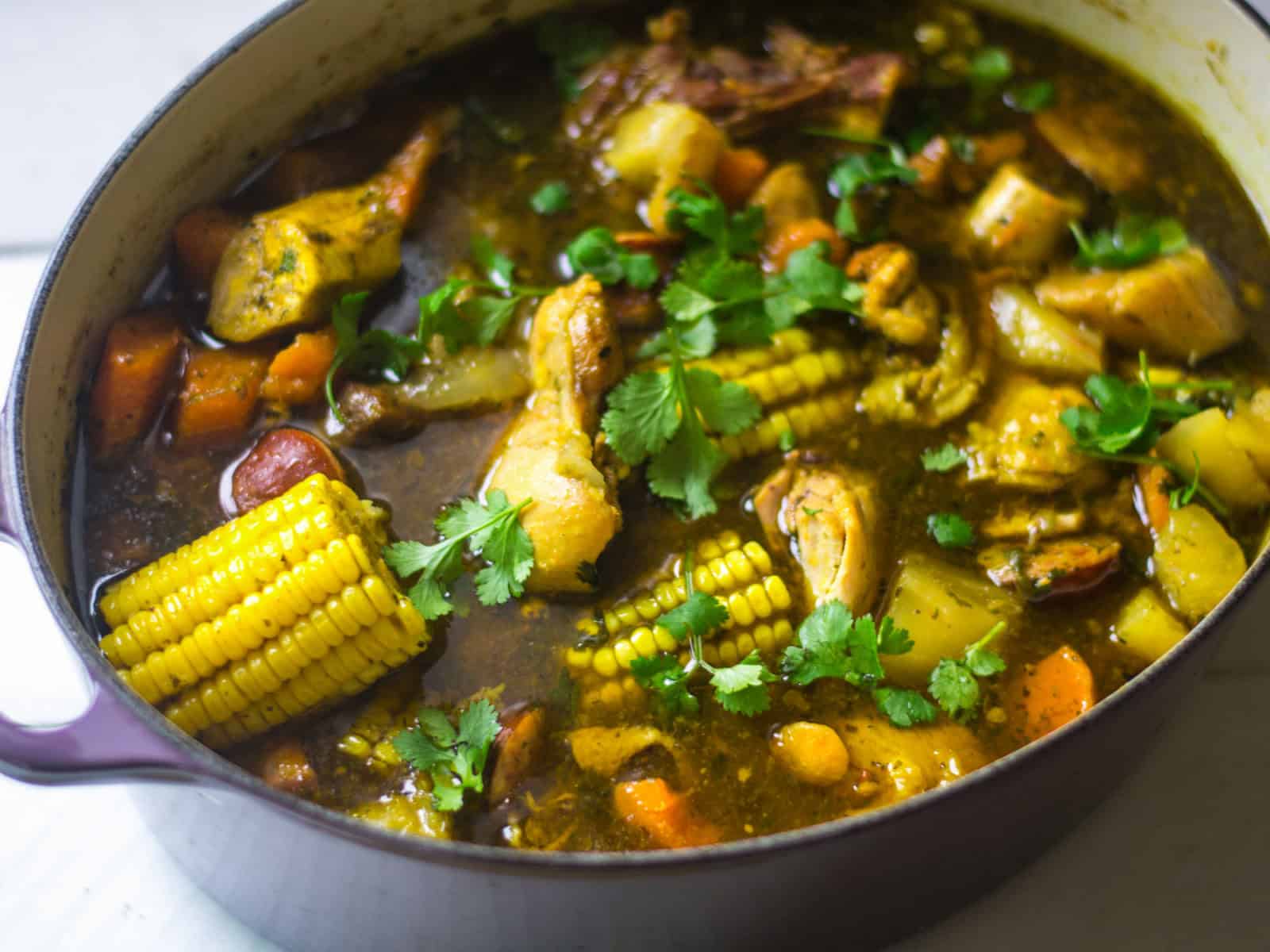
Step 9. Place a lid on, leaving a small opening and continue cooking for another 20-30 minutes until all the vegetables are cooked through and tender.
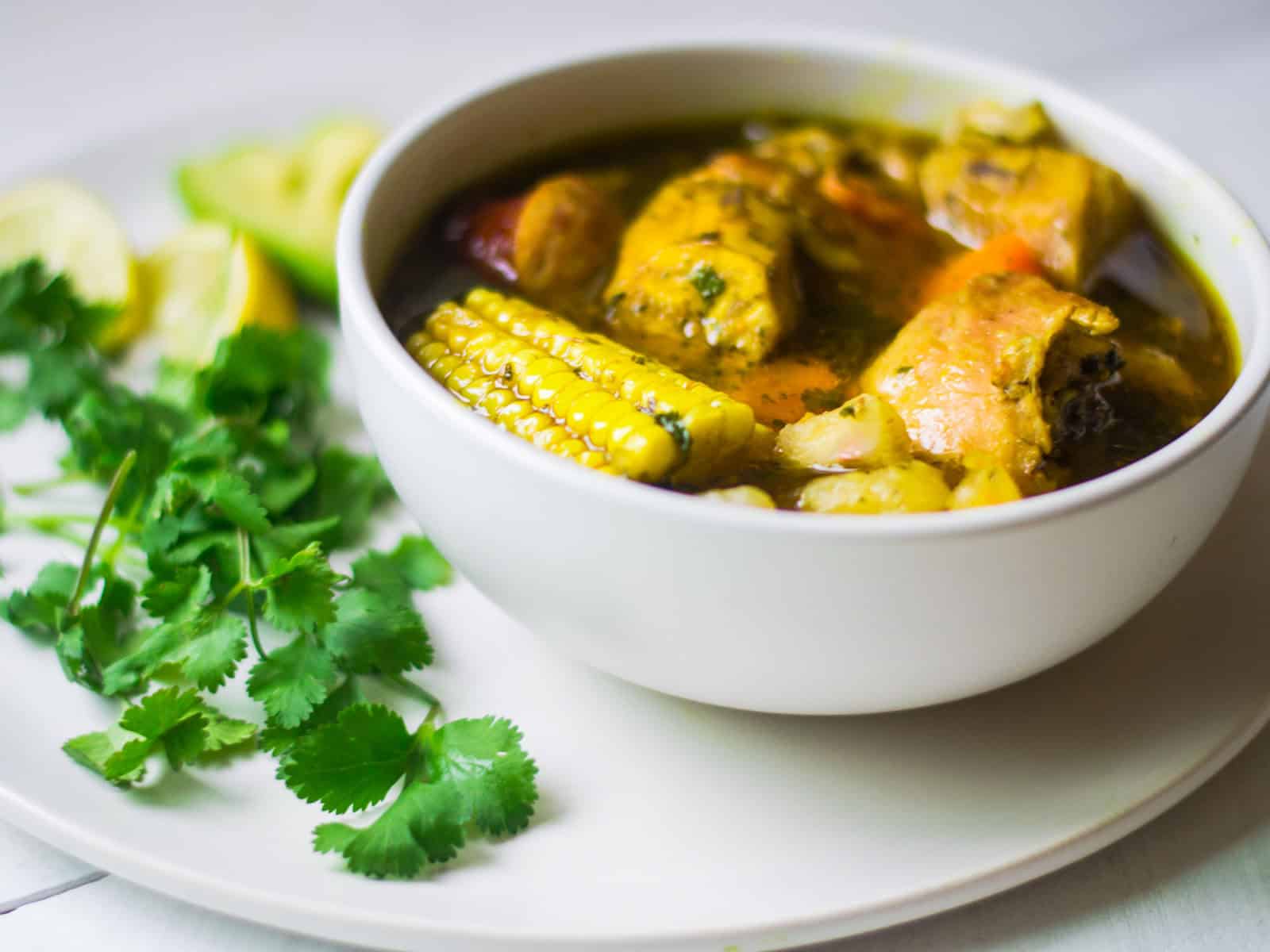
Step 10. Serve the sancocho with sliced avocado and garish with fresh cilantro.
📍 Recipe Tips
- Save Leftover Sofrito: The sofrito recipe makes more than needed for the stew. Freeze the rest in an ice cube tray and use for future soups and dishes.
- Tastes Better as it Sits: The flavors will meld and increase the more the stew sits, so it's even more flavorful reheated the day after.
- Reheating: Store covered in the fridge for up to 3 days and reheat on the stove on low heat, adding a bit of water if necessary.
Recipe FAQs
Yes, Sancocho can be made in advance and often tastes better the next day as the flavors continue to develop. Store it in the refrigerator and reheat before serving.
Sancocho is often served with white rice, avocado slices, and a side of Fried Plantains or a simple green salad.
If your Sancocho is too thick, add a bit more broth or water to reach the desired consistency. If it's too thin, let it simmer uncovered to reduce the liquid until it thickens to your liking.
More Hearty Stew Recipes

Dominican Sancocho (Three Meat Stew)
LittleFerraroKitchen.com
Ingredients
Sofrito
- Small bunch of cilantro and parsley
- ½ red onion roughly chopped
- 4 garlic cloves
- 1 jalapeno seeded and roughly chopped
- 1 bell pepper seeded and roughly chopped
Adobo Seasoning
- 1 tablespoon salt
- 1 teaspoon paprika
- 1 teaspoon turmeric
- 1 teaspoon oregano
- 1 teaspoon black pepper or a few turns from your pepper grinder
Sazon Seasoning
Meat and Soup Base
- 3-4 pork bones
- ½ pound Kielbasa sausage or any smoky sausage, cut into ½ inch slices
- 4 chicken thighs bone in and skin on
- 8 cups of water or chicken stock
- 2 chicken bouillon cubes if not using stock
Vegetables
- 2 plantains peeled and cut into 1 inch pieces
- 1 butternut squash peeled and cut into 1 inch cubes
- 1 medium sized yucca peeled and cut into 1 inch pieces
- 2 ears of corn peeled and cut into 2 inch pieces
- Fresh sprigs of cilantro
Garnish
- Sliced avocado
- Fresh cilantro
- Lime wedges
- Rice optional
Instructions
- Add all the adobo spices together in a bowl and mix well. Do the same with the sazon. Then season the chicken thighs and pork bones with adobo, sazon, salt, and pepper.
- Drizzle olive oil in a large Dutch oven and sear the pork bones and chicken on both sides until the outside is golden brown. Then add sausage and sear on both sides.
- Make the sofrito. To a food processor, add a bunch of fresh parsley, onion, garlic cloves, jalapeno, and bell peppers. Blend until well combined but still has some texture.
- Add 2 heaping tablespoons of sofrito to the pot, stirring to coat everything. Add 8 cups of water and 2 chicken bouillon cubes (or a few teaspoons of concentrated stock) and stir everything together. Bring the stew to a boil and then simmer for about 20-30 minutes or until the chicken cooks through.
- While the stew simmers, prep the vegetables. Yucca has a very thick, waxy exterior, so take your time peeling it and cut it into large 1-2 inch pieces. Do the same with the plantain, butternut squash, and corn.
- Add yucca, plantains, and corn to the pot and continue cooking the stew for 10 minutes until they begin to soften. Then add the butternut squash and a handful of fresh cilantro. Season with salt and pepper and taste for seasoning. Place a lid on the pot, leaving it slightly open, and continue to cook the stew for another 20-30 minutes or until all the vegetables are cooked through and tender.
- Serve stew with sliced avocado, fresh cilantro, and rice (optional).
Notes
- The sofrito recipes makes more than needed for the stew. Freeze the rest in ice cube tray and use for future soups and dishes.
- The flavors will meld and increase the more the stew sits, so it's even more flavorful reheated the day after.
- Store covered in the fridge for up to 3 days and reheat on the stow on low heat, adding a bit of water if necessary.
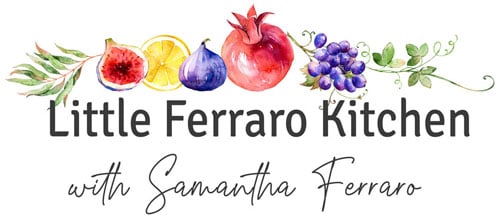



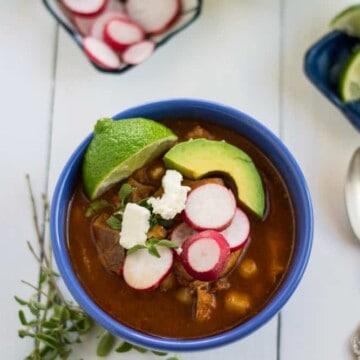
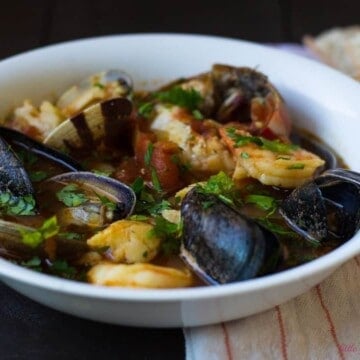




Hakim says
I will hurry and try this one . really sounds welcoming.
Nora says
This is not Dominican Sancocho, this is a modern version. Sancocho doesn't have Kielbasa sausage, it's something you add as you like. The traditional is: Pork, chicken, beef, even smoked pork you can add. I learned that from my grandmother,. Plus I am and old fashioned Dominican that like to cook like old time, with lots of flavor.
Samantha says
Thank you for the comment, Nora!
Nidia says
Wonderful, what a weblog it is! This blog gives useful data to us, keep it up.
Donna V says
I am so confused. I have read several recipes and watched many videos specific to the Dominican version in preparation for making this. Some have used corn and carrots, others have said that they are not authentic to the Dominican version. Others have said that the liquid should be greenish but no green leafy anything should show in the final dish. Any thought?
Samantha says
Hi Donna! I am not Dominican so I can not speak for the authenticity of how the stew is supposed to be. I did research and included the links in the recipe so because I did that..mine could be less authentic because I also used what I could find. Overall it is a fantastic full flavored and full layered stew..green broth or not 🙂
jasmine says
I am Dominican and it really depends on the family preference for eating vegetable and meat as long as you stick to the basics for flavor it should taste amazing, in my family we use these ingredients as well as potatoes carrots and other veggies wich I'm honestly not sure how to translate. however if you take the plantain and the cilantro once they are soft and blend them it will make it nice and thick and not leafy
Samantha says
Hello Jasmine! Thank you so so much for the cooking tip!! I will certainly try blending the plantain ..that sounds so good!
Nick says
Hey thanks for posting ! One of my favorites to add is taro root (also known as yautia or malanga ). I live in NYC SO it's easy to find.
Different types of sweet potatoes are good too . Pretty much any tuber or squash can work !
Samantha says
Hi Nick! Didn't know taro would work in this...thank you for sharing!
Michael Simmons says
Aloha! Thank you for the great recipe, Samantha! It reminds me of my late grandmother, who used to cook it and bring this huge container to our home all the time. I’ve always wanted to learn more about Dominican food.
Midnite says
Although it seems a common mistake, yucca is a totally different plant.
Yuca is the tuber from the Cassava plant - where you get Tapioca Pearls. It is the 3rd-most important staple crop in the world.
Yucca is part of the Agave family - related to the plant Tequila is made from. Though some of the species have edible parts, they seldom are eaten. By the way, Tequila is not made from Yucca, it comes from the Blue Agave plant.
The Yucca plant looks like a palm tree, while the Yuca plant looks like a marihuana plant with extra leaves!!!
Samantha says
Thank you for the clarification!
So There says
It is not yucca. It is yuca.
Samantha says
I have seen both spellings actually...thank you for mentioning that.
Tonya says
Today was the first day I ever tried this stew , and it was awesome !
Samantha says
It is so so good, hearty and full of all sorts of vegetables! Thank you Tonya!
Daria says
Thank you! I just came back from Dominican Republic and am just preparing an article about things to do and eat. I will definitely try this recipe out :)! Well done. Have a great day!
http://www.dariasdiaries.eu
Samantha says
Thank you!!! Wow what a fun trip! Looking forward to seeing your article as well!
Lucy says
Try Kabocha squash, it tastes just like auyama and easy to find in SoCal.
Samantha says
Thanks Lucy!! I will 🙂
Adam J. Holland says
That is one beautiful bowl of goodness!
Samantha says
Thank you Adam 🙂